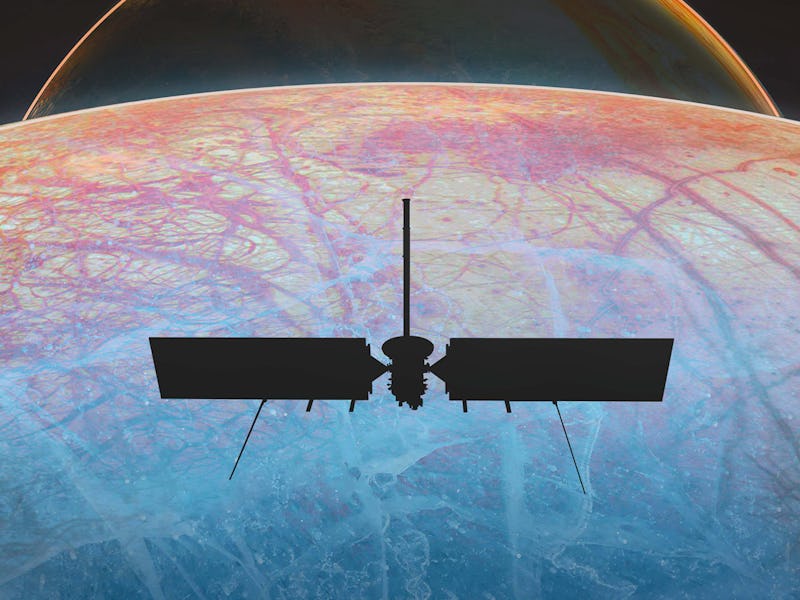Five NASA Space Missions To Look Forward to in 2024
Some events are just a few weeks away.

NASA’s exploration of our skies and space will continue in 2024. Here are some of the high-profile missions that are currently underway, and some events are just a few weeks away, including NASA’s newest stride toward the Moon.
The first flight for its Commercial Lunar Payload Services (CLPS) program is scheduled to launch on January 8. NASA’s Artemis II mission, where humans would return to lunar orbit for the first time since Apollo, could fly as early as November 2024.
There’s plenty to watch from Earth’s surface, too. NASA is debuting a supersonic plane in 2024. There’s also a major astronomical event on April 8: a total solar eclipse.
Far beyond the Earth and the Moon, NASA will send its Europa Clipper spacecraft as early as October 10, which will explore a possible life-sustaining moon around Jupiter.
Here’s a closer look at five major NASA goals for the new year.
Europa Clipper will launch
A NASA poster for its Europa Clipper mission.
Europa intrigues astrobiologists. The Jupiter moon is coated in ice and cracks along the surface as well as jumbled features called chaos regions, hint that it might be geologically active. Jupiter could be stretching and pulling on Europa to the point that it warms it up inside, allowing ice to remain as liquid water below the surface.
An abundance of salt in this hidden ocean would explain why NASA data shows Europa conducting some of Jupiter’s magnetic field. And in the depths, hydrothermal vents may be erupting in a manner like the “black smokers” at the bottom of Earth’s oceans. Dark, salty, deep aquatic regions on Europa might have the recipe for microbial life. But finding out if this is true will be hard. Jupiter has a mighty influence. To evade the danger of Jupiter’s high radiation, NASA’s Europa Clipper spacecraft will take data as it flies by the moon, “clipping” it. Europa Clipper could launch as early as October 10, 2024, though it won’t arrive at Jupiter until 2030.
NASA instruments will fly to the Moon onboard Astrobotic’s Peregrine lander
Pittsburgh-based private space company Astrobotic, is on track to become the first commercial company to successfully land a craft on the surface of the Moon. Their stout, six-foot-tall Peregrine lander will launch from Cape Canaveral, Florida, on board United Launch Alliance’s new Vulcan rocket on January 8, 2024. If Peregrine successfully lands on the Moon on February 23, it would usher in NASA’s partnership with private companies for ongoing delivery services to the Moon instead of building carriers themselves. Once on the lunar regolith, a handful of NASA payloads will begin collecting data about the lunar environment that could give NASA a leg-up on how to approach longer-term Moon exploration with crewed missions.
A total solar eclipse will be seen across North America
Photo taken on Dec. 14, 2020 shows a total solar eclipse witnessed in Freire, La Araucania Region, Chile.
On April 8, 2024, the Moon’s shadow will block the entire disk of the Sun, hiding all but the star’s outer corona. The event is like a sequel to the 2017 Great American total solar eclipse: The lunar shadow will align with the Sun over a stretch of North America. The total solar eclipse begins in the Pacific Ocean, makes landfall in western Mexico, and then moves northeast across the continent, from Texas through Vermont, then out towards eastern Canada, and ending in the northern Atlantic Ocean. NASA officials will be watching from the Indianapolis Motor Speedway in Indiana.
Quesst sonic plane
Artist illustration of NASA’s X-59 Quesst aircraft.
In 2024, NASA will seek to fly its Quesst mission for the first time. The X-59 plane would fly over American land at supersonic speed, hopefully minus the harsh noise. X-59 will fly over several communities, whose members would then report back to the space agency how they perceived the plane’s sound. National and international regulators currently prohibit commercial supersonic flight over land because of the boom noise. Quesst’s success could revolutionize commercial air travel by clearing the sonic obstacle, allowing for supersonic flights, and thus significantly reducing travel time.
Artemis II, with its four-person crew, could orbit the Moon
Left to right, Artemis II astronauts Pilot Victor Glover, Commander Reid Wiseman, and Mission Specialists Christina Hammock Koch and Jeremy Hansen stand in front of the Artemis II Orion Crew Module.
NASA’s Artemis program has repeatedly faced delays, so it’s possible that the follow-up to 2022’s Artemis I mission might not happen by their 2024 target. But the four astronauts of the Artemis II mission have already begun training to ready themselves for that historic launch date when they could become the first humans to fly to the Moon in more than 50 years. Reid Wiseman, Victor Glover, Christina Koch, and Jeremy Hansen could fly as soon as November 2024 on a nine-day mission around the Moon and back and come in faster and hotter into Earth’s atmosphere than any crew has ever done before.